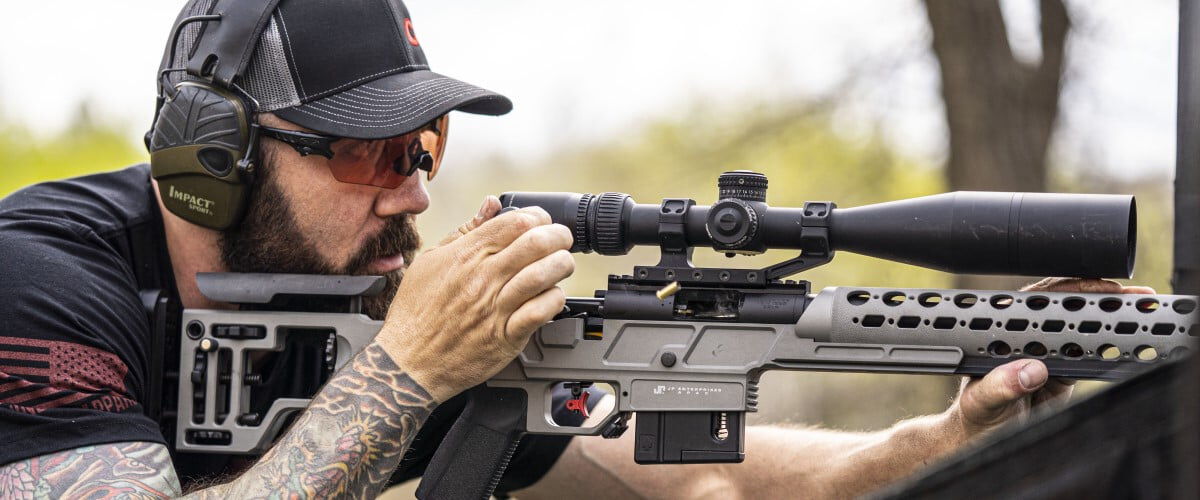
Everyone agrees that a straight line represents the shortest distance between two points. But that’s not always possible, even with rimfire rifles. And understanding that might be one of the most overlooked obstacles to obtaining maximum accuracy.
Rimfire bullets exhibit a distinct trajectory from the bore to a downrange target. Shooters don’t need to dive too deep into physics, but they should know that a bullet starts below the shooter’s line of sight, rises above that at close range, hits the desired zero downrange, and begins a rapid and exponential drop beyond that. Obviously, understanding that trajectory is critical when dialing in a gun. Rimfire expert and CCI ambassador Todd Jarrett says that process begins by obtaining a precise measurement of the center of the rifle bore to the center of the sight.
Sight Height
“Everybody is going to have a different type of scope or red dot with a different type of mount,” he says. “It’s important to know the distance from the center of the bore of the rifle to the center of the bore of the sight, whether it’s a scope or a red-dot, and that measurement should be done with a set of calipers.”
With that information in hand, Jarrett knows where a bullet will rise and fall during flight.
“I personally zero all of my rifles at 50 yards,” he says. “With a 50-yard zero, I know I’m going to have a bore-sight relationship where the bullet is not going to cross and hit that target until a certain distance. I get my students to shoot a target at every distance from 5 yards out to 25 yards. That gives an understanding of what the bore-sight relationship is and where the bullet is going to cross the line of sight at that distance. Typically, that could be 12 to 15 yards, but that could also vary with the projectile you’re shooting.”
Ballistic: Advanced Edition
Check out Ballistic: Advanced Edition, the industry’s No. 1 ballistics app for Apple devices. Powered by the world-renowned JBM Ballistics computer, the app calculates trajectory, windage, velocity, energy, lead, and bullet flight time for any valid range. Ballistic: Advanced Edition can compensate for atmospheric conditions such as temperature, barometric pressure, humidity and altitude.
Download Today
That knowledge also tells Jarrett how the bullet will act downrange.
“With a 50-yard zero on my rifle, I know I will shoot low at 25,” he says. “That could be 1 inch or 1.5 inches, depending on the type of ammunition. The important part here is understanding what your gun is going to be doing at the 50-yard line, 75-yard line and 100-yard line, whether hunting or in a competitive scenario. Understanding what accuracy should look like at 25 or 50 yards away—1-inch groups or better—can get you to 2-inch groups at 100. That’s one of the most sought-after pieces of information people ask about.”
As Jarrett mentioned, the specific load you shoot also makes a big difference, as some guns seem to “prefer” one load over another.
“I would definitely try different types of ammunition, from 36- to 40-grain projectiles, because one rifle might shoot one bullet better,” he says. “Also, consider the speed of a round. I have several guns that shoot better at higher velocity—1,210, 1,220—and some that shoot better at 1,050 or 1,090. I’m looking for precise accuracy with that projectile with that gun and that particular sighting system.”
Elevation Considerations
Of course, precision sighting should be done on a bench at a range. But when you take that .22 rifle afield, another trajectory factor can affect accuracy: shooting uphill or downhill.
Clean-22 Hyper Velocity
CCI Clean-22 Hyper Velocity clocks in at 1,550 fps, while the advanced polymer coating on the 31-grain lead round nose bullet reduces fouling, especially in suppressed rimfires.
Buy Now
“Twenty-five yards is typically not a problem shooting up or downhill, say at a 15- to 20-degree angle,” Jarrett says. “But it drastically changes after 25 yards shooting uphill and downhill. If you are in a hunting situation, when you’re shooting downhill, you typically shoot high. If you’re shooting uphill, the bullet will drop, and you’ll shoot low.”
Jarrett’s solution? Whether hunting or competing, he carries a rangefinder, which gives him the precise distance to the target and the proper elevation and percentage of angle when shooting uphill or downhill.
In-depth discussions about rimfire bullet trajectory might seem like overkill, especially if you’re just plinking or shooting squirrels. However, as Jarrett can attest, a basic understanding of the rise and fall of that projectile goes a long way toward better performance.